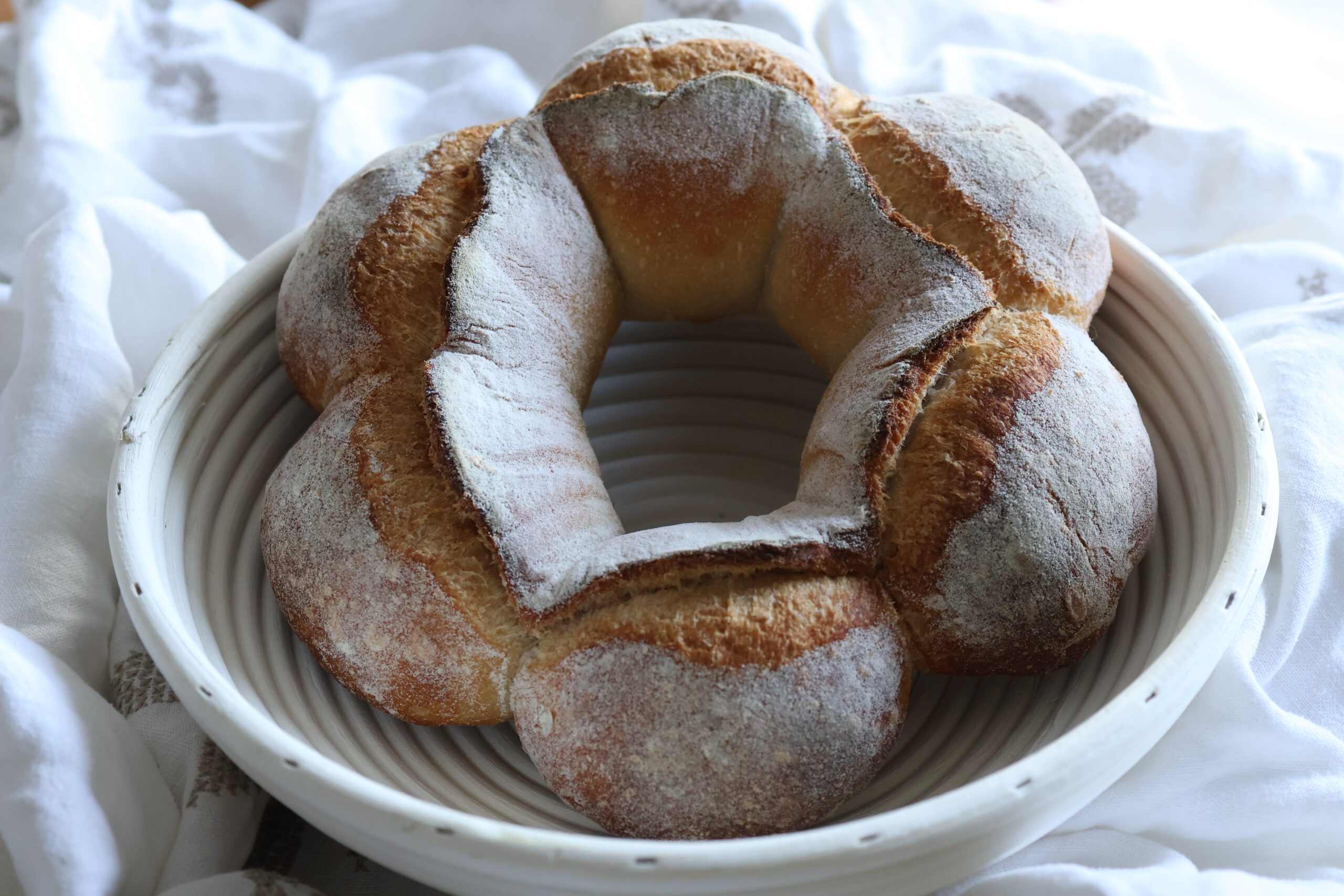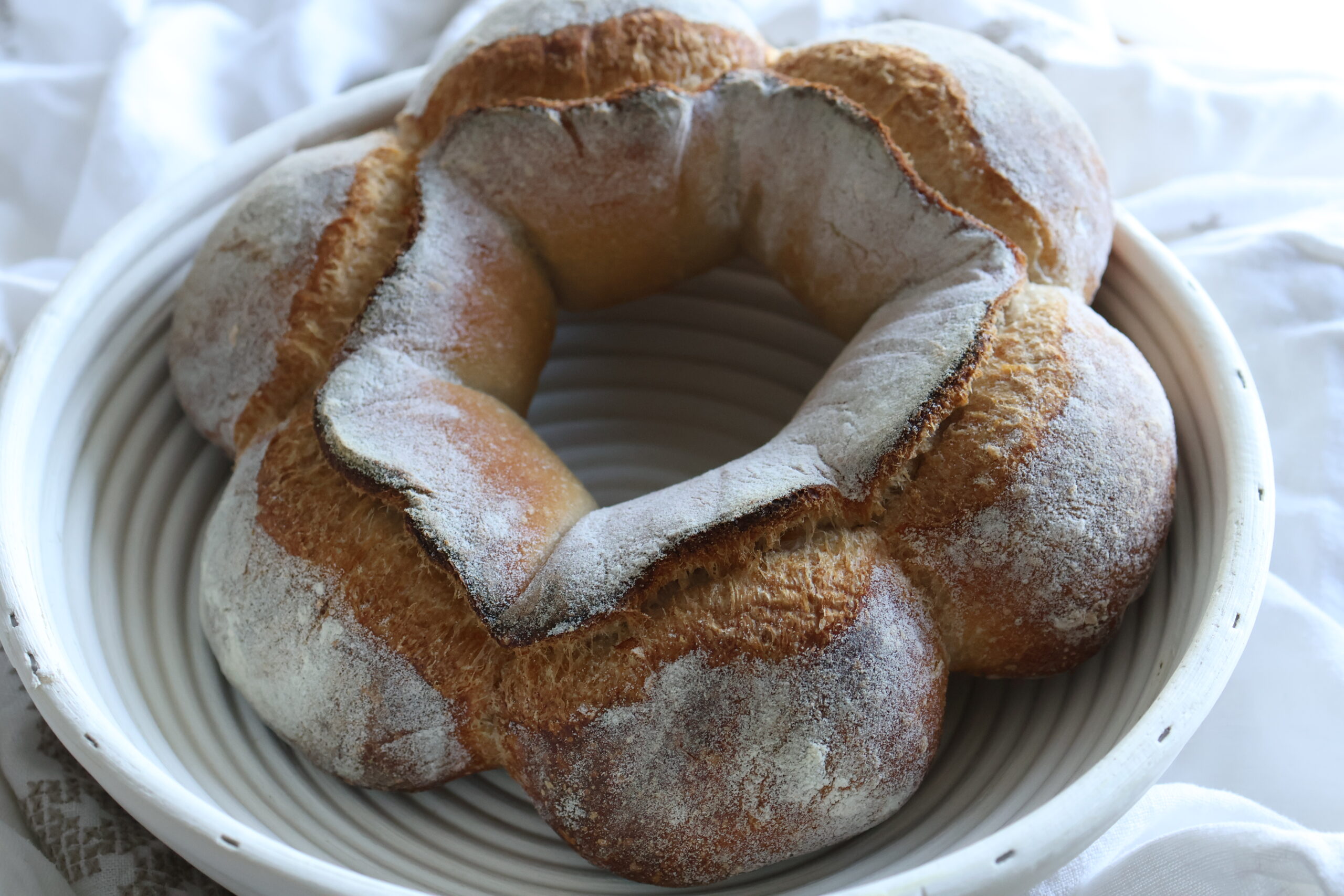

Crown Bread from Bordeaux | Couronne Bordelaise
A medium hydration sourdough baked into a ring shape from six balls of dough held together by a dough collar that pops up into the shape of a crown once baked. This bread hails from Bordeaux, France.
Ingredients
Method
Evening of the First Day (Preparing the Pâte Fermentée):
- In a medium bowl, mix the sourdough starter with water.
- In a separate bowl, whisk together the flour and salt.
- Using a Danish dough whisk or a wooden spoon, add the dry ingredients to the wet ingredients and combine into a course ball. Using lightly floured or wet hands, knead the dough into a smooth ball and place it into a clean bowl covered with plastic wrap. Let it rise at room temperature for 1-2 hours, until the dough is 1½ times its original size.
- Punch down the dough after it has risen and return it to the covered bowl. Refrigerate overnight or up to 3 days.
Next Morning (Making the Final Dough):
- Remove the pâte fermentée from the refrigerator and cut it into about 8-10 small pieces. Let them sit covered in the stand mixer bowl for about 1 hour to warm up.
- In a separate bowl, whisk together the flour and salt.
- Add the water to the pâte fermentée and mix on low speed to break it up. Gradually add the flour mixture and continue mixing until a coarse ball forms. If necessary, add more water to achieve a soft, pliable dough.
- Increase to medium speed and mix with the dough hook for 7-10 minutes, or until it can pass the windowpane test, which is where you stretch a small piece of dough, and if it doesn't rip and you can see light through it, then the gluten is properly developed.
- Transfer the dough to a large, clean bowl, cover with plastic wrap, and let it ferment at room temperature for 3-4 hours. Adjust the time depending on your kitchen temperature; it may take less time if it’s warm. Stretch and fold the dough after the 1st, 2nd, and 3rd hours, then let it rest for the final hour.
Shaping and Proofing the Couronne:
- To create a couronne proofing basket, take a 11"-12" (28-30 cm) shallow bowl, pie dish, or banneton and place a small upside down mason jar or drinking glass in the middle. Drape 1-2 clean, cotton or linen dish towels over the surface of everything, creating a risen center over the jar and a ring around it to create a space to place the dough.
- Flour the towel or liner of your proofing basket very generously. Rice flour instead of wheat flour works great for this because it doesn't get absorbed by the dough and prevents sticking better than wheat flour.
- Dust a work surface with flour and remove the dough from the bowl.
- Divide the dough into six pieces of 105-106 grams each, and one piece of 150 grams. Let them rest, covered, while you flatten the 150-gram ball into a disk about 10" (25 cm) in diameter. Drape it evenly over the center of the basket, reaching halfway to the outer edge. If the dough snaps back, try to flatten it as evenly as possible.
- Flatten the 150-gram ball into a disk about 10" (25 cm) in diameter. Drape it evenly over the center of the basket, reaching halfway to the outer edge. If the dough snaps back, try to flatten it as evenly as possible.
- Shape the remaining six pieces into tight balls and place them seam-side up in the basket, spaced evenly without touching. The dough disk should be partly under the balls of dough.
- Using a bread lame or sharp knife, cut the disk in the center to create six points. Fold each point back over its corresponding ball.
- Proof at room temperature for about 2 hours, or until it has doubled in size and the balls are touching.
Baking:
- Preheat the oven and a bread cloche or large Dutch oven to 450°F (230°C) for at least 1 hour.
- Carefully transfer the loaf (on parchment paper) to the cloche’s base and cover with the lid.
- Bake for 15-20 minutes with the lid on, then 10-15 minutes with the lid off, watching to prevent overbaking. Due to its larger surface area, the couronne may bake faster than other bread shapes of the same weight. If you like to take the internal temperature of your bread, it should be between 200-209℉ (93-98℃) before removing it from the oven. Cool completely on a wire rack before slicing.

Leave a Reply